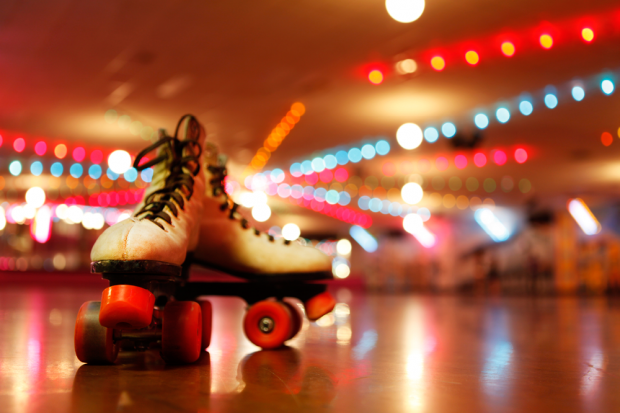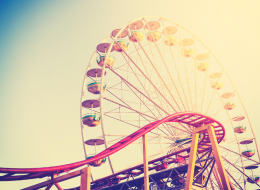Stayin’ Alive The Roller Coaster History of Roller Skating: 12 Surprising Facts
Whatever happened to glitzy, music-filled roller skating rinks? It turns out, they’re still out there, with a decidedly updated twist. “It’s not a declining industry,” Jim McMahon, executive director of the Indianapolis-based Roller Skating Association International, told The Atlantic of the family fun activity.
In fact, as McMahon points out, new roller skating rinks are opening all over the country, and there’s no slowing the proverbial roll. They just might be a bit different than the glittery, disco-filled rinks of the past.
But when you consider the whirly twirly history of roller skates, it’s no surprise the sport has experienced a few evolutions. After all, the very first pair of skates ever presented were a literal smash rather than a fun one. Read on to get the details about that as well as 11 more amusing facts that make up the history of roller skating — one of the world’s most retro pastimes.
1. Roller Skates Made Quite A Theatrical Entrance
When we say roller skates were a literal smash when they were first invented by John Joseph Merlin of Belgium in the mid-1700s, we aren’t kidding. Merlin decided to debut his new invention at a super fancy masquerade ball at Carlisle House in London. His plan was to gallantly skate into the party while simultaneously playing the violin. But, as Thomas Busby points out in his 1805 work Concert Room and Orchestra Anecdotes, “when not having provided the means of retarding his velocity, or commanding its direction, [Merlin] impelled himself against a mirror of more than five hundred pounds value, dashed it to atoms, broke his instrument to pieces and wounded himself most severely.”
2. It Took Another 100 Years Before Roller Skates Could Successfully Turn
Merlin’s mirror crash gave the "fun on wheels" more than just seven years of bad luck. Following the much-talked about incident, it took inventors over 100 years to finally design a pair of skates that could turn. Unveiled in 1863 by American inventor James Plimpton, the four-wheeled “rocker skates” had small springs called “trucks” that allowed people to steer just by leaning left or right. And with that came the introduction of roller skating rinks, with Plimpton opening the very first skating rinks in New York City and Rhode Island and “leasing” the skates to customers.
3. The Very First Roller Skating Rink Was A Converted Dining Room
The same inventor that designed the first roller skates that could turn (James Plimpton) also opened the very first public roller skating rink in the summer of 1866. The location: the dining room of Newport, Rhode Island’s very adult resort hotel, The Atlantic House.
4. The Popularity Of Roller Skating Goes Up And Down With The Economy
The American economy can be tracked via the popularity of roller skating. In the post-Cival War era, the pastime was reserved for upper class adults — many of whom would skate in tuxedos and ball gowns. But labor laws in the early 20th century reduced the average working day, allowing all members of society to enjoy the sport. Unfortunately, many rinks that boomed during the Roaring 20s closed during the Great Depression, but roller skating’s popularity once again surged after World War II, when women started earning their own money and spending it on a session or two of skating. And then the disco age of the 60s and 70s took the sport to its highest status to date, with disco music really helping speed the sport to the top of America’s list of favorite pastimes. The sport’s popularity once again dipped during tight financial times in the early 80s followed by the introduction of inline skates (rollerblades) in the 90s that replaced the four-wheeled skate’s trendy status. But the popularity of roller skates is once again on the rise, with many roller derby rinks popping post the financial crisis of the mid-2000s.
5. Major US Cities Have Different Skate Styles
Just like there are different accents across the United States, there are different skate styles, evidenced by the sport’s boom in the 1970s. Chicago developed a fancy-footwork freestyle type of method called JB skating, thought to be short for the Godfather of Soul, James Brown, while skaters in NYC often went with The Matrix, which is paired skating in which skaters skate around each other (a style that emerged due to the lack of rink space in NYC).
6. Roller Skates Have Been Front And Center In Pop Culture, From Ballet To Films To Music Videos
Roller skates are practically everywhere you turn, at least when it comes to pop culture. The nostalgic devices were used in a Berlin ballet back in 1818, were the center of a 1916 Charlie Chaplin film called The Rink, were the theme of the 1979 Patrick Swayze film Skatetown USA and have appeared in a slew of music videos, including Cher’s Hell On Wheels, Avicii’s You Make Me, Beyoncé’s Blow, and Gwen Stefani’s 2016 Make Me Like You video. Oh, and nobody can forget the time when Gene Kelly famously tap danced while wearing roller skates in the 1955 film It’s Always Fair Weather.
7. Even The Amish, Who Typically Ban Bicycling, Allow Roller Skating
The Amish are known for their no frills, no fun approach to life and typically ban technology and other modern conveniences like automobiles and bicycles. So it’s somewhat of a surprise that many Amish congregations allow roller skates, which have been used for decades in Amish communities. Inline skates of the 90s crossed the line, however, with less than a third of Amish elders approving the much quicker rollerblades speeding into their lives.
8. Roller Skates Have Their Own Museum
The next time you happen to be strolling through Lincoln, Nebraska, you may want to use an hour or two to stop by the National Museum of Roller Skating, where you can learn fascinating facts like a couple wed on roller skates in 1912, and the largest parade of roller skaters (according to Guinness World Records) took place in Poland on June 19, 2014.
9. The Roller Craze Hit The Food Industry ... And Still Exists There Today
Pretty much every young person alive in the 1950s and 1960s saw carhops on roller skates at drive-ins across the country. And if they didn’t see them in person at A&W, Dog n Suds or The Pig Stand, they certainly saw skating carhops on the popular television show Happy Days or in the film American Graffiti. The popularity of skating carhops saw a dip in the late 60s, but Sonic Drive-In still uses carhops at over 3,400 restaurants nationwide and even holds an annual Sonic Skate-Off competition.
10. Roller Skating Rinks Cost Millions To Build And Remodel
Roller skating rinks have quite a large footprint and therefore cost a pretty penny. Jim McMahon of the Roller Skating Association International estimates that it costs millions of dollars to remodel a skating rink, and building a new one is even more expensive because of soaring land prices. “You need at least 20,000 to 30,000 square feet for a roller skating rink,” he says, adding that it’s not just the square footage of the rink itself. “You have to have at least 400 to 500 parking spots for some of these rinks, and the average price is $3 million just to buy the land ... In an area where land value is $400,000 an acre, it’s really tough for a roller skating rink to survive.” Therefore, most rinks that exist today are in suburban and rural areas, where land is much cheaper.
11. Roller Skates Have Inspired Many Famous Quotes
“If the Good Lord had intended us to walk, he would not have invented roller skates,” Gene Wilder’s character, Willy Wonka, famously pointed out in 1971 film Willy Wonka and the Chocolate Factory. And that’s just one well-known quote about the nostalgic invention. Another is H. Jackson Brown, Jr.’s quote, “Talent without discipline is like an octopus on roller skates. There's plenty of movement, but you never know if it's going to be forward, backwards, or sideways.”
12. Roller Derby Is Responsible For The Latest Skating Boom
Roller derby, which is a contact sport played on roller skates that incorporates colorful theatrics, is what’s mostly responsible for the recent roller revolution. Though the sport can be traced back to the 1930s, its contemporary grassroots revival in the early 21st century has given it a new spin, shown in the 2009 film Whip It that stars Drew Barrymore and Ellen Page. And roller derby has become so popular, it was being considered for the 2020 Olympics. “Roller derby has been really helpful for skating,” McMahon concludes. “People are also practicing in roller rinks for speedskating, ice skating and dance skating. We’re at levels like we were 20 years ago.”
Looking for more fun facts to pull out of your hat during parties? Find out what a person's walking style reveals about his or her sex life, and why walking barefoot may have the power to keep you super young.
Notice concerning medical entries:
Articles having medical content shall serve exclusively for the purpose of general information. Such articles are not suitable for any (self-) diagnosis and treatment of individual illnesses and medical indications. In particular, they cannot substitute for the examination, advice, or treatment by a licensed physician or pharmacist. No replies to any individual questions shall be effected through the articles.







